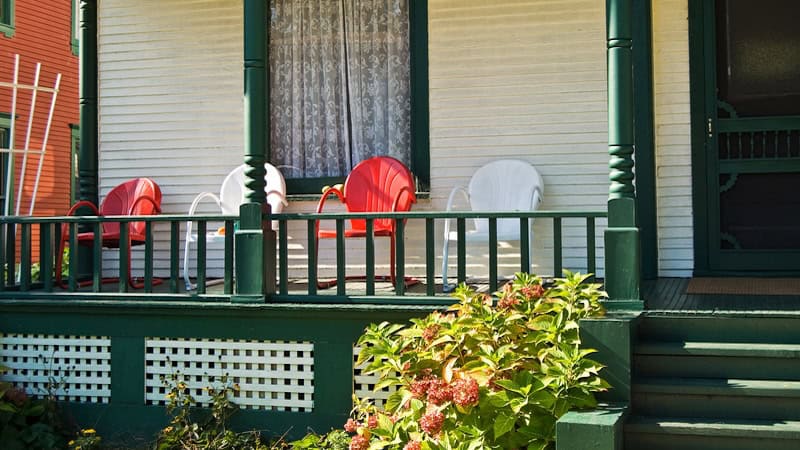Memories of the Front Stoop
Childhood thoughts of days gone by

During his childhood, the front stoop represented a wealth of positivity, from youthful games and solitude to social connections. Roger Pierangelo recalls his front stoop experiences in the 1950s.
In 1957, life seemed to be wrapped in a gentle simplicity, a contrast to the complexities of today. At least, that’s how it felt to me then, with the world appearing uncomplicated and my concerns minimal thanks to my parents. There was a special kind of magic in that era; everyday objects could effortlessly change into whatever my imagination desired. Creativity and playfulness were celebrated, and the joy of transforming the mundane into the extraordinary was a cherished part of childhood.
Since I wasn’t wealthy, I learned to create my own joy when I was alone, and in doing so, I discovered the profound ways in which creativity, fascination, and fantasy could enrich life. I would transform into a commanding general of a plastic army, orchestrating grand battles with each soldier’s distinct voice. Baseball cards became prized tokens in a worldwide contest as I expertly flipped them into a wastepaper basket, narrating the action with all the flair of a sports announcer. Marbles turned into boulders, crashing down a wooden slope into toy houses, and I played the hero rescuing countless plastic soldiers from impending doom – those valiant figures that seemed so busy and brave, so strong and immortal but despite all that, went to bed every night in a shoe box in my closet.
Yet, among all my imaginative adventures, one inanimate object stood out for its boundless potential: the front stoop. Those three layers of bricks were a canvas for endless possibilities, transforming into whatever my imagination could conceive, making it a cornerstone of my childhood wonders.
In the 1950s, the front stoop was more than just a place to sit – it was the heart of the neighborhood, akin to the country clubs of today. It was where people gathered, exchanging stories and laughter for hours on end. My mother would graciously serve food and drinks to friends and neighbors, creating a warm, welcoming atmosphere that made everyone feel at home. Despite its modest seating capacity of just four, the stoop was always bustling with people, its charm acting like a magnet that drew everyone together. When a family was out on the stoop, it felt like an open invitation for anyone to join. It was a remarkable feeling, seeing the block transformed into a close-knit community where everyone shared their daily lives, from personal anecdotes and family tales to work experiences and heartfelt losses. The stoop was a symbol of connection, embodying a genuine sense of caring and concern that wove us all together.
For me, the stoop often transformed into Yankee Stadium, with each game of stoopball turning into a grand spectacle. In those moments, I was both the star player – often embodying the legendary Mickey Mantle – and the enthusiastic announcer, weaving together play-by-play commentary with each dramatic throw. The stoop became my personal Stoop Stadium, a magical arena where I could save the game with every pitch, fully immersing myself in the fantasy of athletic prowess and cheers.
The stoop also held a special place as a sanctuary during our games of tag. It was our refuge, a place of safety and comfort where we could escape the relentless pursuit of being “IT.” The anxiety of being tagged made the stoop seem like a sacred fortress, and we would race with all our might, hearts pounding, to reach its welcoming embrace. There, in its familiar and protective space, we found solace from the game’s pressures, the stoop offering a comforting reminder of home and security.
The stoop also became the perfect vantage point for the eagerly anticipated daily visit of the ice cream man, whether it was the familiar Bungalow Bar or the ever-popular Good Humor truck. From this elevated perch, with an unobstructed view down the block, I could spot him as he turned onto 251st Street, a sight that always sparked a flurry of excitement and anticipation.
In a way, the stoop served as a great equalizer among the houses on our block. Each home on 251st Street boasted its own stoop, and despite the cookie-cutter uniformity of the houses, each stoop had its own character. Most of these homes featured a modest three-step stoop leading up to the front door, neatly centered along the façade. However, there were a few that had a more impressive four-step stoop, a subtle yet noticeable difference that in our eyes symbolized a hint of affluence. Why this was the case, I never fully understood, but it was a small, unspoken distinction that marked the neighborhood’s social landscape.
The stoop was also a cherished refuge for quiet reflection and contemplation. In 1957, my concerns were simple – mostly centered around who I would play with the next day – but the stoop offered a serene space to be alone, a luxury of solitude that was never accompanied by loneliness. In those days, solitude wasn’t something to fear, for you were always surrounded by a network of extended family, close friends, and beloved pets. The presence of these familiar faces and faithful companions made feelings of isolation a distant concern. Choosing to be alone on the stoop was a peaceful retreat, a place where I could gather my thoughts and enjoy a moment of calm amidst the comforting bustle of life. The stoop became my personal sanctuary, offering a quiet, contemplative space during a vibrant and connected world.
Dr. Roger Pierangelo is a licensed clinical and forensic psychologist for over 45 years who has published numerous books on parenting, education, special education, and psychology. His is writing The Baby Boomer Diaries, from which these stories originate, with his wife Jackie and their stories have been published online and in newspapers.
Jackie Pierangelo is a former newspaper editor of a local newspaper chain and has published several books on parenting, self-help, and humor. She has also had humorous articles published in national newspapers.
Read more childhood memories and other contributions from Boomer readers in our From the Reader department.
Have your own memories, essays, or other stories you’d like to share with our baby boomer audience? View our writers’ guidelines and e-mail our editor at Annie@BoomerMagazine.com with the subject line “‘From Our Readers’ inquiry.”



